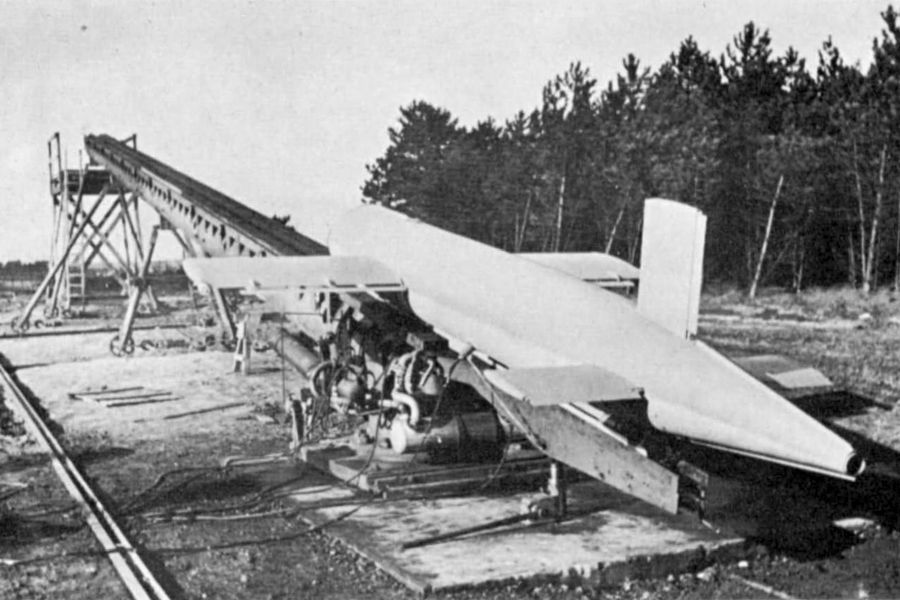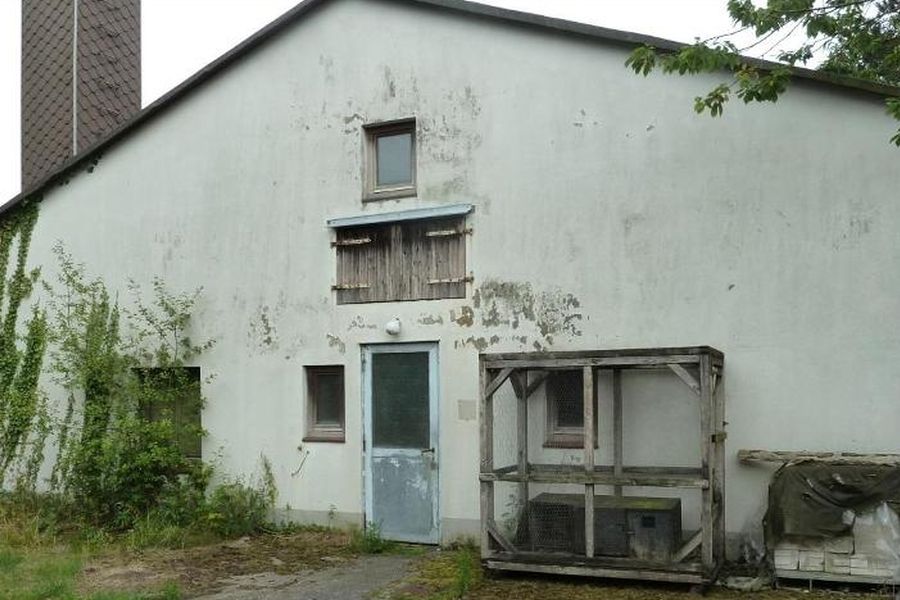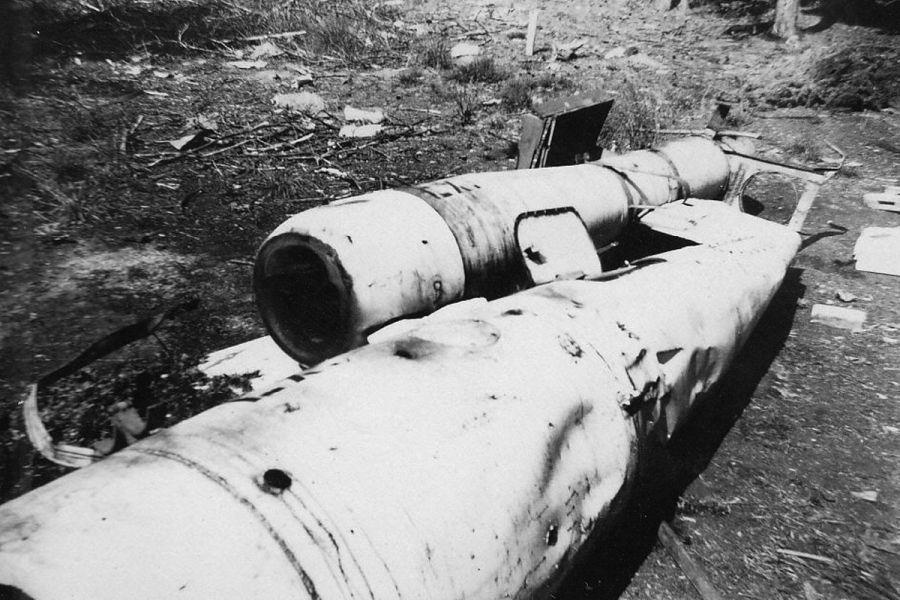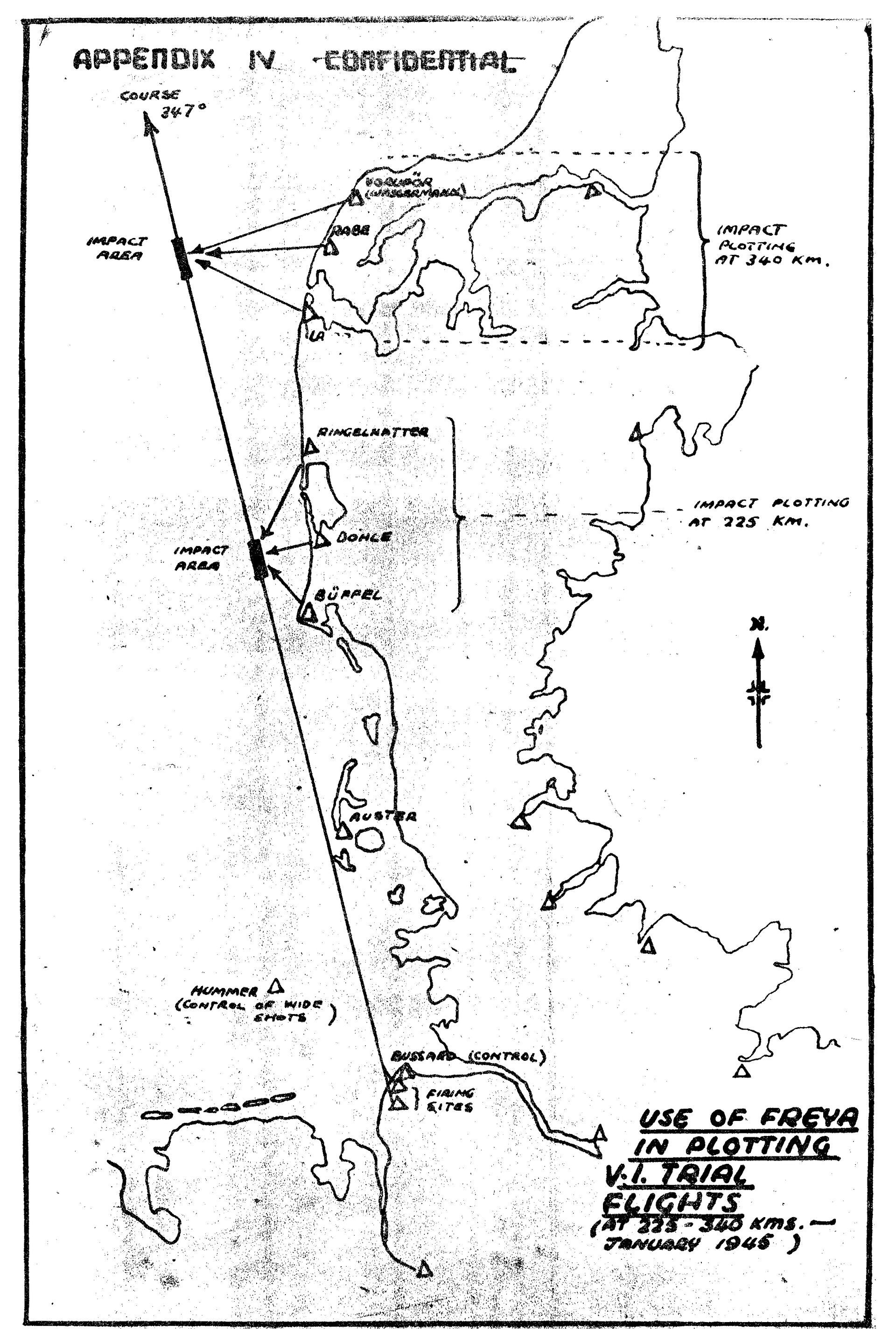
As early as 1937, various tests with rockets and rocket engines were carried out at the Altenwalde firing range, including the Walter engine (Me 163/Komet). From 1943, the Blohm and Voss BV 143 B naval glide bomb, which was similar to the Fiesler Fi 103 (V1), was also tested. This model was intended to be used from launch ramps for coastal defense against sea targets. It was also possible to drop the glide bomb from a medium-sized bomber and guide it to the target. The associated swiveling Walter catapult type 1 at the Altenwalde firing range was located in the immediate vicinity of today's west gate.

A Blohm & Voss BV 143 glide bomb on a Walter Rohrschleuder Type 1 at the Altenwalde Marine Artillery Shooting Range. Source: public domain
From the beginning of 1943, the German Armed Forces' Bombardment Command and the Luftwaffe's Test Command carried out test firing with glide bombs and Fiesler Fi 103 (V1) cruise missiles in the southwest of the Altenwalde firing range. These firing tests were carried out separately from the artillery firing operations at the Altenwalde firing base. For the test firing, there were an assembly building with an adjoining hall section for the Fiesler 103 (V1), as well as two launch ramps, so-called Walter slingshots. From 1943, there was a rotating Walter tube slingshot for the BV 143 glide bomb and from 1944 at the latest there was a fixed Walter slingshot for firing tests with the Fiesler Fi (V1) on the test stand near the former fire hole pond at the west gate. The Walter tube slingshots were aligned to the northwest. The slingshots were steam catapults in which a piston filled with hydrogen peroxide (“T-Stoff”) and potassium or sodium permanganate (“Z-Stoff”) generated steam through chemical reactions and propelled the missiles. The range-increased V1 missiles tested in Altenwalde were each filled with 810 l to 1,025 l of fuel. The missiles were usually filled at the lowest point of the slingshot.At the end of 1944, the Soviet Army, which was advancing ever further towards Reich territory, forced parts of the V1 test facility in Karlshagen-Penemünde/MV to be relocated to the firing range in Altenwalde with equipment, personnel and scientists.In February 1945, tests began under the leadership of the Waffen-SS with the range-increased version Fi of the Fiesler 103 (Vergeltungswaffe 1). The launch pad required for these tests was built in late autumn 1944 with an orientation of 312°. After takeoff, the flight direction over the mudflats was changed to a course of 347° using the contact drive on the control unit. The test models had a deliberately staggering, wave-like flight movement that was intended to make it more difficult for enemy fighters to shoot them down. At the time, firing a single V1 cruise missile cost 119,600 Reichsmarks. The target flight direction was along the Danish coast so that the tests could be monitored from there. The test ranges were 225 km and 340 km. In these areas, the descent could be tracked and measured from several stations on the mainland. The measuring devices from the various night fighter zones of the Kammhuber Line, along the North Frisian and Danish North Sea coasts, were used for this. However, there were several misfires that crashed to the ground shortly after takeoff, much to the detriment of the surrounding farmers. This often led to wildfires that affected their pastures and fields. A Fiesler Fi 103 is said to have not flown north after takeoff, but headed in the opposite direction, towards Bremervörde. At some point it turned around and came back to Altenwalde, where it crashed to the ground nearby. After the war, contemporary witnesses repeatedly reported the distinctive engine noises of the V1, especially when the units were running on the test bench. Up to 29 of the flying bombs are said to have been stored at the Altenwalde firing range by the end of 1945. This is where the German Army later operated its Scheibenhof site administration. The test site consisted of the following buildings: a workshop hall with a rail connection and a hall section to the south for the assembly of the test components. There are also four smaller buildings next to a garage, which was probably used as a warehouse for individual parts and completed cruise missiles. Due to various renovations over time, there is no longer any evidence of the period of rocket research at this location. The management of this secret series of tests in Altenwalde was apparently the direct responsibility of SS-Obergruppenführer Hans Kammler, who was responsible for this research. From April 12, 1945, the test firing was stopped and the launch pads destroyed.
M.B.
Picture left:
- Area for fixed Walter pipe slingshot, 1944 - 1945Area for rotating Walter pipe slingshot, 1943 - 1944Assembly hall for the Fiesler 103 (V1). Later battery hall of the Bundeswehr.West gate Former Bundeswehr tank washing facility

The destroyed Walter Rohrscheuder after 1946 on the Altenwalde shooting range. Source: http://www.v2rocket.com

The former assembly hall for components of the Fiesler FI 103 (V1) flying bomb. Source: MB

Various rocket parts after the end of the war in a forest at the West Gate, on the right the rear wing of a Fiesler Fi 103 (V1). Source: http://www.v2rocket.com

Further remains of a V1 in the adjacent forest area of the test site.
Those: http://www.v2rocket.com
Dank für die Hintergrundinformationen und Unterstützung zu diesem Thema gilt vor allem :
Gerd Wildfang - Military buildings of the Cuxhaven Fortress
The website - https://www.christianch.ch/index.phpThe website - http://www.v2rocket.com/




